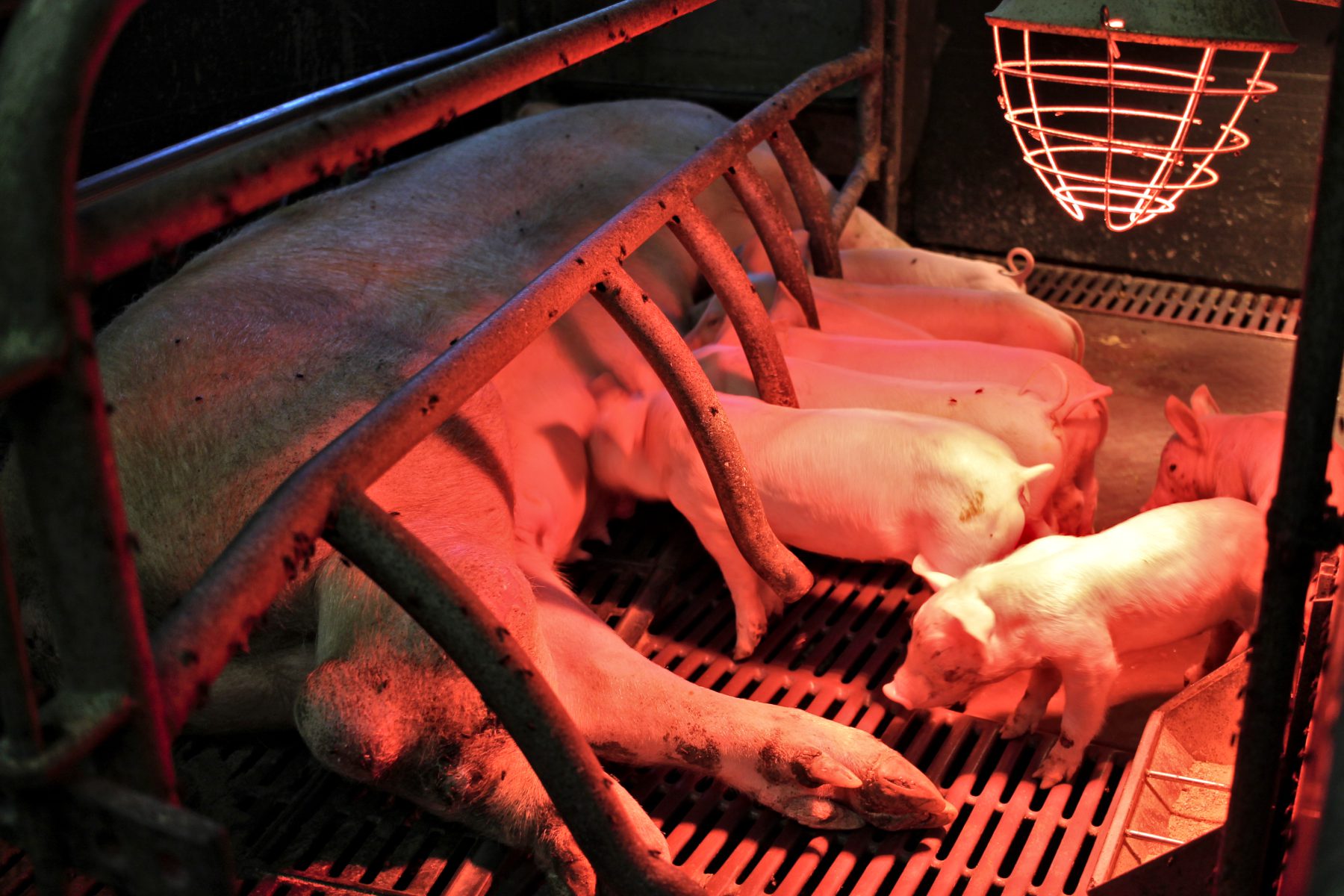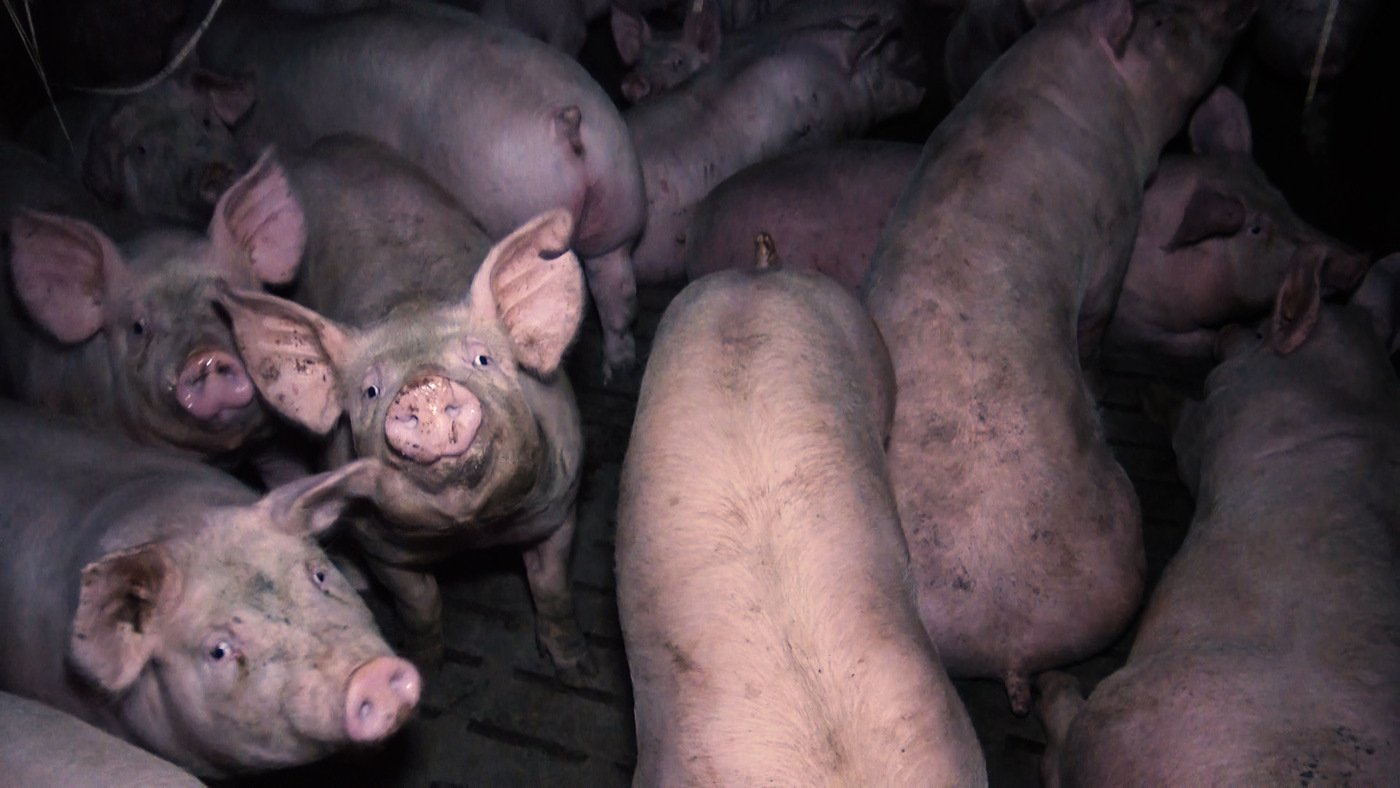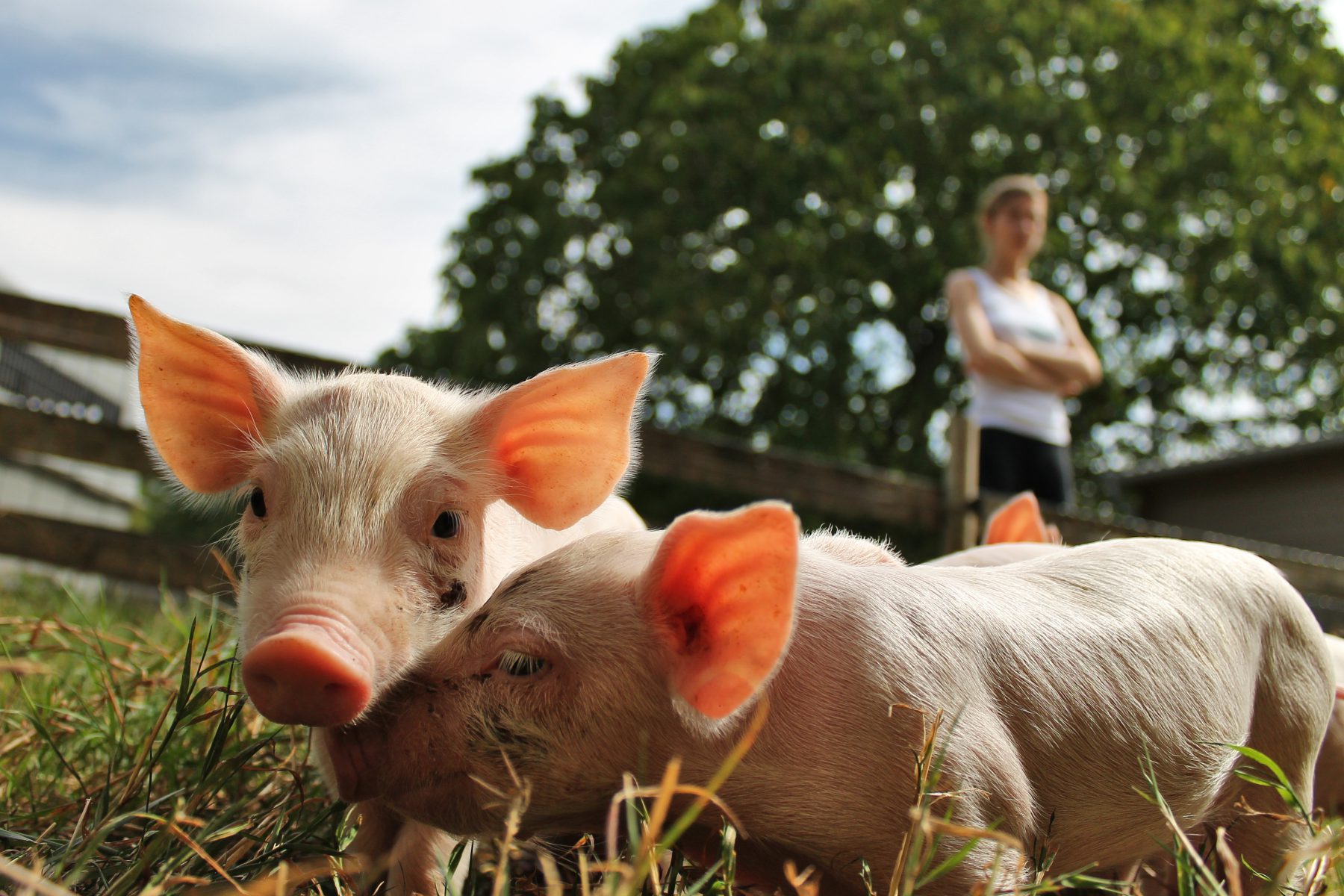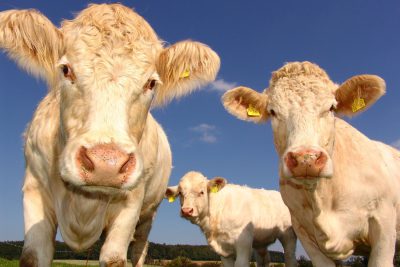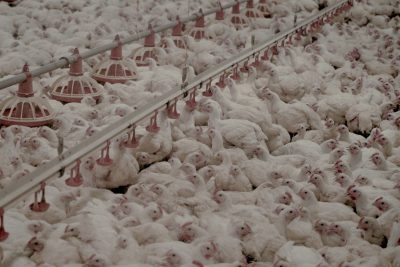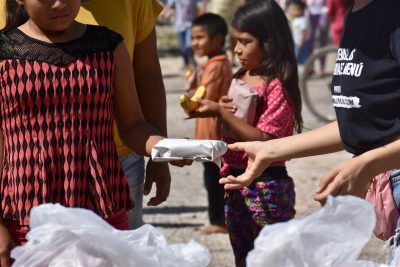Global pork production has increased rapidly over the past 30 years and now there are more than 670 million farmed pigs on the planet. Alongside rising numbers, the way pigs are farmed has also changed, and the stress of intense confinement for these bright, social inquisitive animals can amplify the number and type of pathogens they host. This is not just a risk for farmworkers and slaughterers who tend to have the closest contact with live pigs, it means anyone who eats their meat is also susceptible. And if an infectious and transmissible pathogen passes from pigs into people – as happened in 2009 – then every person on this planet could be at risk.
What Is a Zoonotic Disease?
Zoonotic diseases are caused by germs that spread between animals and people. Some affect just the person who comes into contact with those germs while others can then pass from person to person as an infectious disease.
Tuberculosis, measles, whooping cough, typhoid, leprosy, and the common cold all jumped from animals to people when we started domesticating, farming and exploiting animals. More recently, avian flu, swine flu, SARS, MERS, AIDS, Ebola and Covid-19 all did the same.
We pay a heavy price when we farm, trade, slaughter, eat and exploit animals.
How Do Diseases Spread Between Animals And People?
Direct Contact
Infectious agents may be passed through direct physical contact with animals. This can be through being bitten or scratched, or by coming into contact with infected skin, wounds, saliva, urine or feces.
Indirect Contact
Infectious droplets may contaminate surfaces or they may be in the air after being coughed or sneezed out. They may then be inhaled or ingested, or infect open wounds.
Vector-borne
Diseases may be spread if an insect bites an infected animal and then bites a person.
Foodborne
Many pathogens are in the foods we eat, particularly in animal products. People become sick when they eat contaminated foods.
Waterborne
Water may become contaminated, particularly by feces of infected animals. Those who swim in it, drink it or otherwise come into contact with it may fall ill.
18 Zoonotic Diseases Associated With Pigs
Anthrax
A serious bacterial disease that can affect the respiratory and gastrointestinal tracts of most mammals. A person may become infected if its spores enter through a skin abrasion or wound, if they inhale contaminated particles, if they are bitten by an infected insect or if they eat infected pig meat. Symptoms include nausea, vomiting, abdominal pain and severe bloody diarrhea. It can be fatal.
Ascariasis
More commonly known as mange or scabies. It is caused by parasitic mites and can infect more than 100 species of mammals, including humans. Typically, the mites cause an allergic reaction, resulting in intense itching. Treatment is with anthelmintic medications.
Brucellosis
A bacterial disease that affects the reproductive systems of animals as well as causing recurring fevers and arthritis. People can become infected through direct contact or aerosol exposure. (It can also transmit through drinking untreated infected cows’ milk.) As with animals, symptoms in people include flu-like signs, joint pain, and recurring fevers. In more severe cases, organs – including the liver, heart and central nervous system – may become inflamed. It can be fatal.
Campylobacteriosis
Caused by bacteria that is found in the intestinal tracts of animals. Most cases are associated with handling or eating infected poultry but pigs may also be infected. It is transmitted to people through direct contact and through eating undercooked infected meat, or when the feces of infected animals contaminate other food products. Symptoms include diarrhea, vomiting, abdominal pain, headache and muscle ache. It can be fatal among children, the elderly and immunosuppressed individuals.
Cysticercosis
A rare parasitic tissue infection caused by the larval cysts of a particular pig tapeworm. Humans can become infected with the tapeworm after eating undercooked contaminated pork. The tapeworm is not the real problem, however, but if its eggs are then shed through feces and are accidentally ingested, cysts may form in the muscles, eyes and even the brain. Cysticercosis can be fatal.
Erysipeloid
A rare bacterial disease, spread through direct contact with infected pigs, and most commonly through skin wounds. It can cause swellings and lesions on the hands, and in rare cases complications can include encephalitis, meningitis and sepsis.
Hepatitis E
A virus usually spread by ingesting food or water contaminated with infected feces, and there is increasing evidence to show it can be transmitted through eating undercooked pork. The virus is common in pigs although they rarely get sick. In people, however, it can cause liver infections, particularly in the immunocompromised or pregnant women.It can be fatal.
Leptospirosis
A bacterial disease that affects many species of wild and farmed animals, and also people. In pigs, it may cause fever and abortion. The bacteria can transmit to people through direct or indirect contact with infected animals. The symptoms can be mild (flu-like aches and fever) to severe, including mental confusion, jaundice and damage to the liver, kidney and brain. It can be fatal.
Listeriosis
A bacterial disease that is usually spread from pigs to people through direct contact or inhalation, or through eating infected meat. A skin infection may occur in those who handle infected pigs but the most serious effects occur in the elderly and the immunocompromised. Pregnant women rarely show symptoms themselves but it can prove fatal to the fetus or the newborn baby.
Rabies
A severe viral disease that can affect all mammals including people. It is rare in pigs but outbreaks have occurred. It is usually transmitted through being bitten by an infected animal but can also occur if saliva gets into a person’s nose, mouth or eyes, or into a wound. Symptoms include fever, headache, confusion and abnormal behavior. Death is almost certain.
Ringworm
A skin disease caused by a fungus, which can affect many animal species, including pigs. People can become infected via direct contact. The most common symptom is itchiness and the appearance of a rash in a ring, from which it gets its name. It can be treated with topical fungal medication.
Salmonellosis
A common bacterial infection which can cause severe diarrheal illness, especially in children, the elderly and the immunocompromised. The bacteria are shed in feces, which then contaminate foods, usually of animal origin, including pig meat. Transmission may also be via direct contact with infected animals. Salmonellosis causes about 1.35 million infections, 26,500 hospitalizations, and 420 deaths in the United States every year.
Streptococcus Suis
A relatively rare but serious bacterial agent that can affect various animals including pigs and people. In pigs, it can cause meningitis and septicemia and it can do the same in people. The bacteria can be passed via a wound, through aerosol inhalation and also by ingestion. It can be fatal and sixty percent of those who do recover have permanent hearing loss.
Swine Influenza
An acute viral respiratory disease that circulates among pigs and can also infect people. Transmission is initially via close contact with pigs, and not all types can spread from person to person. However, in 2009, a novel virus H1N1 emerged in the human population, spread quickly and became a pandemic, which caused an estimated 6o million cases, 275,00 hospitalizations and 12,500 deaths in the United States. It is still circulating.
Tetanus
A bacterium that can be found in the feces of pigs (and other animals) or in soil infected with their feces. The bacterium usually enters the body through a wound. Thankfully, the disease is rare, but infections are very serious, as tetanus may result in stiffness and muscle spasms in the jaw and neck that can cause death.
Toxoplasmosis
A parasitic disease that can infect various animals including pigs, often without symptoms. It can be passed to people who eat food contaminated with infected feces. Health risks are greatest in those with weakened immune systems and in pregnant women. Symptoms include fever and aches, but the protozoa can also invade the muscles, heart, lungs, eyes and nervous system. It can be fatal.
Trichinellosis
Caused by a parasite found in pigs that can be transmitted to people who eat infected undercooked pork. In people, symptoms include nausea, diarrhea and vomiting. In severe cases, patients may experience difficulty coordinating movements, and have heart and breathing problems. It can be fatal.
Yersiniosis
A bacterial infection that spreads from pigs to people who eat undercooked pork (or drink contaminated cows’ milk). Infection can cause fever, abdominal pain and diarrhea that may last from 1 to 3 weeks. Young children are more likely than adults to become sick, and are more likely to die. The Centers for Disease Control and Prevention estimates it is responsible for 117,000 illnesses, 640 hospitalizations, and 35 deaths in the United States every year.
How You Can Protect Yourself From Zoonotic Swine Diseases
Since most people do not come into close contact with live pigs, farmworkers and slaughterers are most likely to become infected with a swine zoonotic disease through direct contact. However, most people do still eat animal products made with pig meat, and so many more are at risk this way. To reduce the risk of foodborne diseases, it is best to avoid handling and eating pig meat (and all other animal products) altogether.
But diseases can be highly infectious, and some zoonotic diseases from pigs can spread rapidly among the human population, whether or not individuals eat the meat. For that reason, not only should we consider carefully what we as individuals choose to eat, we should also support campaigns that call for an end to factory farming. Cramming stressed animals into crowded, filthy barns is not only an ethical issue, it’s a recipe for yet another global health disaster.
Who Is At A Higher Risk Of Serious Illness From Zoonotic Diseases?
While anyone can get sick from a zoonotic disease, some people are more at risk than others. Children under five, the elderly, pregnant women and people with weakened immune systems are all more at risk of serious illness if they become infected with a zoonosis.
However, should a novel pig virus form that has high transmissibility, anyone on the planet – young, old, healthy, sick – could be at risk.
Conclusion
Farming, trading, slaughtering, butchering and eating pigs creates the opportunity for a significant number of pathogens to jump into people, causing serious sickness and even death. It is not the pigs’ fault, of course. Far from it. They become sick themselves because of the terrible conditions they are kept in.
Instead of treating the animals with whom we share this planet with respect – because after all they are here with us, not for us – we have treated them appallingly. Pigs are caged throughout their pregnancies, and have their young taken from them over and over. They are inseminated and bred from repeatedly until they are no longer optimally fertile and after years of physical and psychological torment, they are trucked to slaughter, with most never having walked on the earth or breathed fresh air. Jonathan Safran Foer writes, “The meat that we eat today overwhelmingly comes from genetically uniform, immunocompromised, and regularly drugged animals lodged by the tens of thousands into buildings or stacked cages.” In factory farms we have not only created a monstrous cruelty, we have created a hothouse for pandemics.
Yet, none of this is inevitable. Factory farming continues only because people buy the meat. We are not helpless in the face of global pandemics. The power to change the future lies entirely with us, and the choices we make about what to eat.
Click HERE to find out more about trying a vegan diet with our free Vegan Starter Kit, Health & Nutrition Guide and delicious plant-based recipes.

